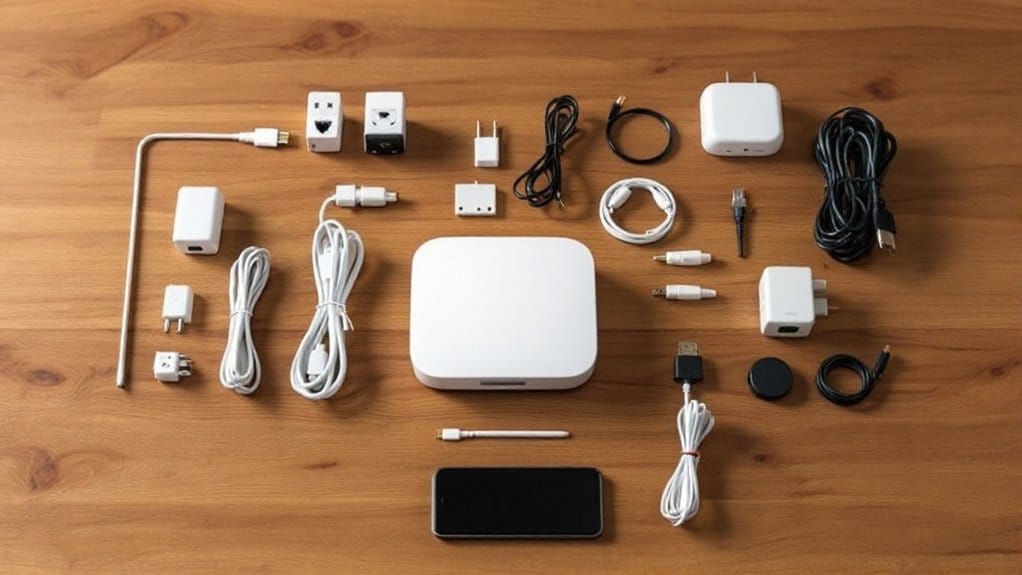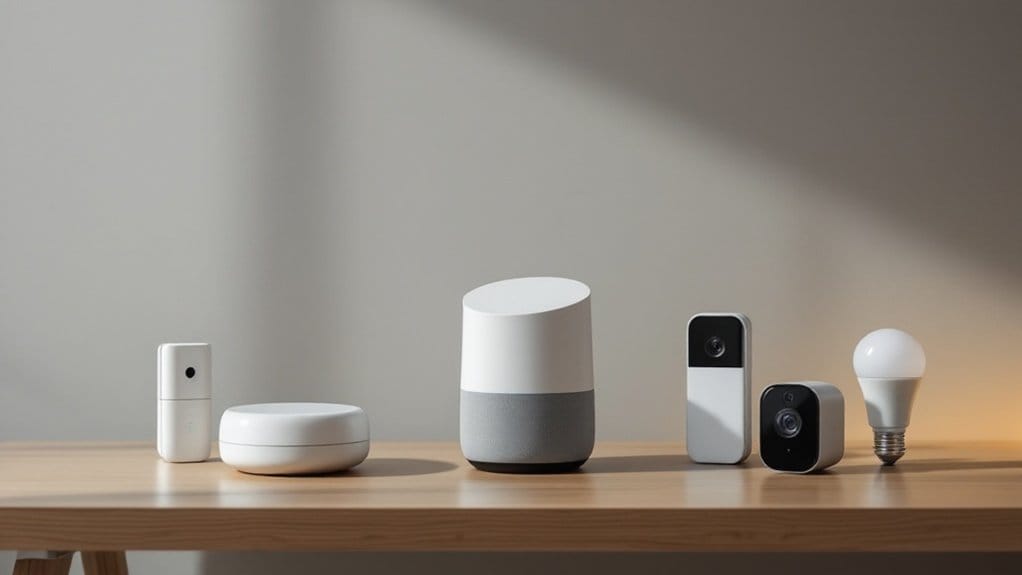You’re about to transform your home with a smart hub, starting with the simple unboxing process. You’ll verify compatibility and set things up step by step, ensuring everything works seamlessly. Stay tuned for the full guide that makes this setup straightforward and reliable.
Unboxing the Smart Home Hub
You’ve just received your new Smart Home Hub, so start by carefully opening the box.
You’ll find the hub nestled in protective packaging—gently remove it to avoid damage.
Inside, locate the main device, power adapter, and any quick-start guides.
Handle the hub with care, as it’s delicate; set it on a flat surface nearby.
Unwrap cables and accessories methodically, ensuring nothing gets tangled.
Take a moment to appreciate the sleek design and compact size—it’s built for easy integration into your space.
Now, inspect for any visible issues like scratches, though you’re not troubleshooting yet.
This unboxing sets the stage for a smooth setup experience.
Remember, you’re building your smart home one step at a time, so enjoy the process.
Once everything’s out, you’re ready to move on.
Verifying Compatibility and Requirements
The next step is verifying that your Smart Home Hub works with your devices and meets the required specs.
To start, check the manufacturer’s website or user manual for a compatibility list.
You’ll need to confirm that your devices—such as lights, locks, or sensors—support the same wireless protocols, like Wi-Fi, Zigbee, or Z-Wave, as your hub.
Ensure your devices, like lights, locks, or sensors, support the same wireless protocols—such as Wi-Fi, Zigbee, or Z-Wave—as your hub.
This guarantees seamless integration.
Next, review the hub’s system requirements.
Make sure your home network has a stable internet connection with the minimum recommended speed, typically at least 2.4 GHz Wi-Fi.
Also, verify that your devices’ hardware and firmware versions align with the hub’s needs.
For example, check if your hub requires a specific power source or environmental conditions.
Installing the Required App
After verifying compatibility, install the app for your Smart Home Hub to control and manage your devices.
This app acts as your central command center, letting you easily add and monitor gadgets.
Download it from your smartphone’s app store by searching for the official name and following the prompts—it’s straightforward and quick.
To make the process smooth:
- Locate the right app: Search using the exact brand name to make sure you’re getting the authentic version.
- Check requirements: Verify your device’s OS meets the app’s minimum specs before proceeding.
- Complete installation: Tap download, wait for it to install, and open it to confirm everything works as expected.
You’ll then have a user-friendly interface at your fingertips, ready to streamline your smart home setup.
Establishing Wi-Fi Connection
How do you connect your Smart Home Hub to Wi-Fi?
First, verify your hub is powered on and near your router.
Open the app you installed earlier on your smartphone or tablet.
You’ll see a dashboard; navigate to the settings or setup section.
Select the Wi-Fi connection option, which might be labeled as “Network” or “Connect to Wi-Fi.”
The app will scan for available networks.
Choose your home Wi-Fi from the list.
If it’s secured, enter your password carefully.
Confirm the details, then let the hub connect—it may take a minute.
Once linked, you’ll get a success notification.
Test the connection by checking the hub’s status in the app.
This step verifies your hub communicates reliably.
Remember, a strong signal prevents future issues, so position it ideally.
Avoid common pitfalls like incorrect passwords or interference.
Now your hub’s online and ready for the next phase.
Pairing Devices With the Hub
With your hub now connected, you can pair your smart devices to build a seamless home network.
This step integrates lights, thermostats, and locks for easy control.
You’ll use the hub’s app or built-in features to detect and link devices quickly.
To get started, follow these essentials:
- Check compatibility: Make sure your devices work with your hub’s ecosystem, like Google Home or Amazon Alexa.
- Initiate pairing mode: Press the device’s button or use voice commands to enter discovery mode.
- Confirm connection: The app will guide you through verification, showing successful links.
Once paired, your setup grows smarter without extra hassle.
Test each device to confirm responsiveness, creating a responsive environment tailored to your needs.
This foundation sets the stage for a fully interconnected home.
Configuring Hub Settings
Now that your devices are paired, you’ll tweak the hub’s settings to customize your smart home experience.
With devices paired, fine-tune your hub’s settings to personalize your smart home experience.
First, open the hub’s app or web interface and navigate to the settings menu.
Here, adjust network preferences, like Wi-Fi connections, to guarantee stability.
Set up user profiles for family members, assigning access levels to control what each person can manage.
Customize notification settings so you receive alerts for specific events, such as motion detection.
Explore automation options, like scheduling lights to turn on at dusk, but keep it simple for now.
Don’t forget to configure language and time zone settings for accuracy.
Test these changes immediately by triggering a device; if something doesn’t work, revisit the menu.
This step personalizes your setup, making daily interactions seamless and intuitive.
Always save your configurations before exiting.
Ensuring Full Functionality
After configuring your hub’s settings, test each device to confirm it’s responding as expected.
This step confirms your smart home runs smoothly and identifies any issues early.
Use your hub’s app or interface to trigger actions like turning lights on or locking doors, verifying real-time responses.
To engage fully with your setup, follow these key checks:
- Verify connections: Confirm every device links securely to your Wi-Fi network and hub, fixing any signal drops immediately.
- Run compatibility tests: Confirm all devices work with your hub’s software, updating apps or firmware as needed.
- Simulate scenarios: Test routines, such as automated lighting at dusk, to catch glitches and fine-tune performance.
Conclusion
Now that you’ve unboxed, verified, and set up your smart home hub, you’re all set to enjoy a seamless, connected life. By installing the app, linking to Wi-Fi, pairing devices, and configuring settings, you’ve guaranteed everything works smoothly. Take a moment to test responsiveness, then explore more features—your smart home’s just getting started! Remember, it’s all about making your daily routine easier and more fun.









